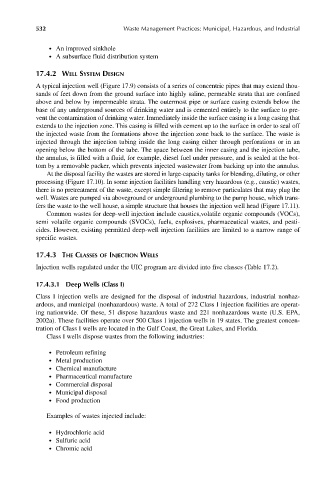Page 561 - Materials Chemistry, Second Edition
P. 561
CAT3525_C17.qxd 1/27/2005 12:44 PM Page 532
532 Waste Management Practices: Municipal, Hazardous, and Industrial
● An improved sinkhole
● A subsurface fluid distribution system
17.4.2 WELL SYSTEM DESIGN
A typical injection well (Figure 17.9) consists of a series of concentric pipes that may extend thou-
sands of feet down from the ground surface into highly saline, permeable strata that are confined
above and below by impermeable strata. The outermost pipe or surface casing extends below the
base of any underground sources of drinking water and is cemented entirely to the surface to pre-
vent the contamination of drinking water. Immediately inside the surface casing is a long casing that
extends to the injection zone. This casing is filled with cement up to the surface in order to seal off
the injected waste from the formations above the injection zone back to the surface. The waste is
injected through the injection tubing inside the long casing either through perforations or in an
opening below the bottom of the tube. The space between the inner casing and the injection tube,
the annulus, is filled with a fluid, for example, diesel fuel under pressure, and is sealed at the bot-
tom by a removable packer, which prevents injected wastewater from backing up into the annulus.
At the disposal facility the wastes are stored in large-capacity tanks for blending, diluting, or other
processing (Figure 17.10). In some injection facilities handling very hazardous (e.g., caustic) wastes,
there is no pretreatment of the waste, except simple filtering to remove particulates that may plug the
well. Wastes are pumped via aboveground or underground plumbing to the pump house, which trans-
fers the waste to the well house, a simple structure that houses the injection well head (Figure 17.11).
Common wastes for deep-well injection include caustics,volatile organic compounds (VOCs),
semi volatile organic compounds (SVOCs), fuels, explosives, pharmaceutical wastes, and pesti-
cides. However, existing permitted deep-well injection facilities are limited to a narrow range of
specific wastes.
17.4.3 THE CLASSES OF INJECTION WELLS
Injection wells regulated under the UIC program are divided into five classes (Table 17.2).
17.4.3.1 Deep Wells (Class I)
Class I injection wells are designed for the disposal of industrial hazardous, industrial nonhaz-
ardous, and municipal (nonhazardous) waste. A total of 272 Class I injection facilities are operat-
ing nationwide. Of these, 51 dispose hazardous waste and 221 nonhazardous waste (U.S. EPA,
2002a). These facilities operate over 500 Class I injection wells in 19 states. The greatest concen-
tration of Class I wells are located in the Gulf Coast, the Great Lakes, and Florida.
Class I wells dispose wastes from the following industries:
● Petroleum refining
● Metal production
● Chemical manufacture
● Pharmaceutical manufacture
● Commercial disposal
● Municipal disposal
● Food production
Examples of wastes injected include:
● Hydrochloric acid
● Sulfuric acid
● Chromic acid

